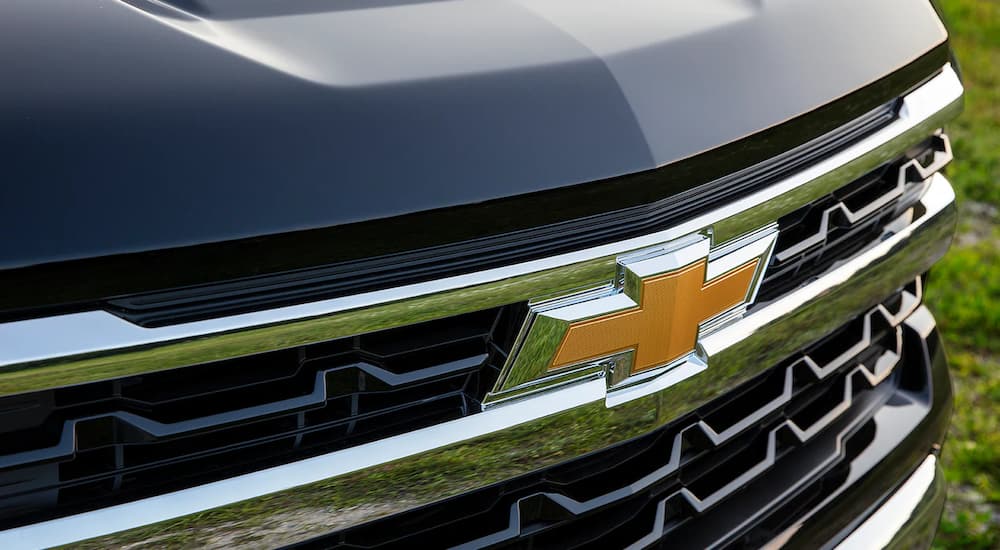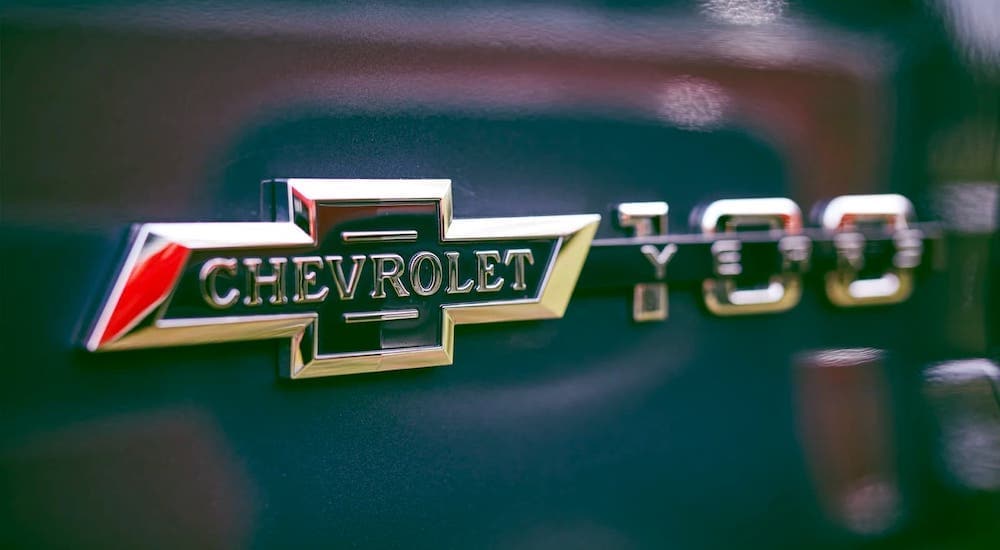
Your search for a Fair Oaks Chevy dealer inspired a deep dive into one of America’s most iconic brands. The Chevy logo, officially known as a bowtie, is symbolic of Chevrolet’s rich history as one of America’s automotive pioneers. The bowtie represents everything Chevrolet stands for, from its ingenious engine design of legends like the small-block V8 to the sheer capability of workhorses like the best-selling Silverado and electrified models like the Bolt EV. But there’s far more to the Chevy logo than even this.
Chevy’s logo is one of the most disputed in the world because its origin is uncertain. Chevrolet was founded in 1911 by businessman William C. Durant and race car driver Louis Chevrolet. The bowtie made its official debut in 1913 on a model featured in The Washington Post that encouraged readers to “look for this nameplate.” But who designed the bowtie, and what’s the inspiration behind it? Still shrouded in mystery, here’s a closer look at the Chevy logo and the many tales of its origins.
A French Hotel: 1908
Durant is credited with the bowtie’s design, a fact that few people dispute. However, there’s ongoing speculation over what inspired the logo. In 1961, The Chevrolet Story published an official account of the bowtie in celebration of Chevrolet’s 50th anniversary in the automotive business. In the publication, Chevrolet claims that the bowtie’s origins predate the company’s founding to a time when Durant traveled the world.
“It originated in Durant’s imagination when, as a world traveler in 1908, he saw the pattern marching off into infinity as a design on a wallpaper in a French hotel,” The Chevrolet Story read. “He tore off a piece of the wallpaper and kept it to show friends, with the thought that it would make a good nameplate for a car.”
If the story proves true, Durant’s world travels occurred during the end of his tenure with the Buick Motor Company, which he ran from 1904 to 1908. After turning the floundering company into America’s leading automaker, Durant left the company to launch General Motors. He purchased Buick, the Olds Corporation, Pontiac, Cadillac, and AC-Delco. Since these companies were already established, Durant had no use for the logo until tragedy struck when he lost control of GM to the bank in 1910. This tragedy forced him to team up with Louis Chevrolet to form the Chevrolet Motor Company in 1911, giving him a prime opportunity to use the logo just a few years later.

A Newspaper Ad: 1911
Following his success with the Buick Motor Company in 1908, Durant married his second wife, Catherine Lederer, of Michigan. Catherine’s account of the Chevrolet bowtie has nothing to do with a French hotel. Instead, she suspected the bowtie came from one of their many vacations.
During a 1968 interview, Catherine said her late husband discovered the Chevy logo during their vacation to Hot Springs in 1912. As they relaxed in their hotel room, Durant spotted a design in the newspaper. “I think this would be a very good emblem for the Chevrolet,” he exclaimed, according to Catherine’s recollection. Yet, ironically, Catherine never confirmed the design or if it was the bowtie, a discrepancy that further shrouded the Chevy logo in mystery.
Catherine’s oversight has prompted many historians to look deeper into her account. Ken Kaufmann, a historian and the editor of The Chevrolet Review, took the endeavor upon himself and set out to prove the story’s validity. So, what did he discover? Kaufmann found an ad for the Southern Compressed Coal Company in the November 1911 edition of The Constitution, an Atlanta newspaper. Advertising Coalettes as a refined fuel for fires, the ad featured a slanted bowtie emblem and was published just nine days after the founding of Chevrolet.
Kaufmann questions if Catherine and Durant saw the same ad just months later during their trip to Hot Springs. It’s entirely possible, but why would Durant wait another year before debuting the bowtie? That’s a question few can answer.
Dinner Time Doodles: 1910s
Yet another account of the Chevrolet logo’s origins comes from Durant’s daughter, Margery. Born in 1887, Margery was well-versed in her father’s business antics by the time he founded Chevrolet in 1911. As a socialite, she shared the spotlight with her father and later recounted her childhood and his lifetime of successes and failures in her 1929 book, My Father. In the book, Margery shared that one of her father’s favorite pastimes was doodling nameplate designs during dinner. “I think it was between the soup and the fried chicken one night that he sketched out the design that is used on the Chevrolet car to this day,” she wrote.
Is Margery’s memory correct? No one knows. Margery was 24 years old when Chevrolet was founded, meaning her account of the logo is far from a child reminiscing about her father’s grandiose success. However, her passion for the spotlight and adventure, two traits she shared with her father, left many to question the accuracy of her account.
By 1931, Margery’s past was incredibly colorful, with three marriages and a round-the-world flight to share her love of aviation. Was her story another attempt to popularize the Chevrolet name and her father’s success as the founder of General Motors? That’s a question that remains unanswered like so many others concerning the Chevy bowtie.
An Homage to Louis Chevrolet: 1910s
For some, the Chevrolet logo has nothing to do with a French hotel, a newspaper ad, or dinnertime doodles. Instead, it has everything to do with Louis Chevrolet. The bowtie mirrors the Swiss cross, paying homage to Louis Chevrolet’s Swiss heritage. But how feasible is this explanation?
The son of a watchmaker, Louis Chevrolet was born in the Swiss town of La Chaux-de-Fonds and spent his childhood in the French town of Beaune. During this time, his passion for racing flourished, inspiring him to move to Paris, where he found work as an automotive mechanic and immediately started saving money to move to the United States. By 1900, his dreams came true, landing him in Canada before he made his way to New York, where a Swiss emigrant hired him.
Chevrolet spent the next several years honing his skills, eventually making headlines with his first car race in 1905. By 1911, his need for speed caught the attention of Durant, and the two teamed up to form the Chevrolet Motor Company. The company got off the ground, but Durant and Chevrolet faced a significant dilemma, with each having very different visions for the company's future. By 1914, Durant’s vision to build affordable vehicles forced Chevrolet out of the company and gave the racecar driver no other choice but to leave his name behind.
This timeline makes it entirely possible that Durant designed the bowtie logo as a tribute to Chevrolet. However, the claim's validity is rooted in how soon the pioneers discovered their vastly different ambitions. Were they already at odds in 1912 and 1913? If so, would Durant have paid homage to Chevrolet with the logo even amid their disagreements?

A History Shrouded in Mystery
Today, the Chevrolet logo represents the pioneering spirit of an American automaker that helped put the world on wheels. Its origins may still be in question, but that doesn’t discount what it means to American drivers. For some, it reflects the capability of a road warrior like the Silverado that can handle any job without breaking a sweat. For families, it's the confidence of getting behind the wheel of an SUV like the Tahoe, knowing everyone is safe and comfortable. For others, it's the adrenaline that comes from an icon like the Corvette and the satisfaction of building a greener future behind the wheel of an EV like the Bolt.
Regardless of its origin, the Chevy bowtie is forever ingrained in the American automotive landscape. It doesn’t matter where it started. All that matters is what it stands for and what it means to drivers across the country and around the world.